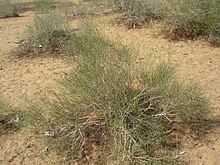Calligonum
| Calligonum | |
|---|---|

| |
| Calligonum polygonoides | |
| Scientific classification | |
| Kingdom: | Plantae |
| Clade: | Tracheophytes |
| Clade: | Angiosperms |
| Clade: | Eudicots |
| Order: | Caryophyllales |
| Family: | Polygonaceae |
| Subfamily: | Polygonoideae |
| Genus: | Calligonum L. |
| Species | |
|
See text | |
Calligonum is a genus of plants in the family Polygonaceae with about 80 species across the Mediterranean Sea region, Asia and North America.
Description[edit]
Plants of the genus Calligonum are shrubs, diffusely but irregularly branched, with flexuous woody branches. Leaves are simple, opposite, nearly sessile, linear or scale-like, sometimes absent or very small, linear or filiform, distinct or united with short membranous ochreae. Flowers are bisexual, solitary or in loose axillary inflorescences. Flowers have persistent, 5-parted perianths not accrescent in fruit, and 10-18 stamens with filaments connate at the base. The ovary is tetragonous.[1][2]
Taxonomy[edit]
The genus Calligonum was first published by Carl Linnaeus in 1753.[3] It is placed in the subfamily Polygonoideae, tribe Calligoneae, along with its sister genus, Pteropyrum.[4]
Species[edit]
- Calligonum acanthopterum I.G.Borshch.
- Calligonum alatosetosum Maassoumi & Kazempour
- Calligonum aphyllum (Pall.) Gürke
- Calligonum arborescens Litv.
- Calligonum azel Maire
- Calligonum babakianum Godw.
- Calligonum bakuense Litv.
- Calligonum bucocladum Bunge
- Calligonum bykovii Godw.
- Calligonum calvescens Maire
- Calligonum caput-medusae Schrenk
- Calligonum crinitum Boiss.
- Calligonum crispum Bunge
- Calligonum cristatum Bunge
- Calligonum ebinuricum N.A.Ivanova ex Soskov
- Calligonum eriopodum Bunge
- Calligonum junceum (Fisch. & C.A.Mey.) Litv.
- Calligonum klementzii Losinsk.
- Calligonum laristanicum Rech.f. & Schiman-Czeika
- Calligonum leucocladum (Schrenk) Bunge
- Calligonum litwinowii Drobow
- Calligonum macrocarpum I.G.Borshch.
- Calligonum matteianum Drobow
- Calligonum mejidum Al-Khayat
- Calligonum microcarpum I.G.Borshch.
- Calligonum mongolicum Turcz.
- Calligonum murex Bunge
- Calligonum polygonoides L.
- Calligonum rubicundum Bunge
- Calligonum santoanum Korovin
- Calligonum schizopterum Rech.f. & Schiman-Czeika
- Calligonum setosum (Litv.) Litv.
- Calligonum spinosetosum Maassoumi & Batooli
- Calligonum taklimakanense B.R.Pan & K.M.Shen
- Calligonum tetrapterum Jaub. & Spach
- Calligonum trifarium Z.M.Mao
- Calligonum triste Litv.
- Calligonum turbineum Pavlov
References[edit]
- ^ "Calligonum". Flora of Pakistan. Retrieved 2013-11-23 – via eFloras.org, Missouri Botanical Garden, St. Louis, MO & Harvard University Herbaria, Cambridge, MA.
- ^ "Calligonum". Flora of China. Retrieved 2013-11-23 – via eFloras.org, Missouri Botanical Garden, St. Louis, MO & Harvard University Herbaria, Cambridge, MA.
- ^ "Calligonum L." International Plant Names Index (IPNI). Royal Botanic Gardens, Kew; Harvard University Herbaria & Libraries; Australian National Botanic Gardens. Retrieved 2019-03-08.
- ^ Schuster, Tanja M.; Reveal, James L.; Bayly, Michael J. & Kron, Kathleen A. (2015), "An updated molecular phylogeny of Polygonoideae (Polygonaceae): Relationships of Oxygonum, Pteroxygonum, and Rumex, and a new circumscription of Koenigia", Taxon, 64 (6): 1188–1208, doi:10.12705/646.5
